As an owner of a saltwater aquarium, at one point or another, you will likely toy with the idea of introducing live rock and coral to your tank, creating a reef environment. One of the most popular fish species in the hobby are saltwater angelfish, the problem with most angels is that they are not "reef safe", meaning they shouldn't be exposed to a reef environment because they will eat small invertebrates or fish that reside within the reef or even eat the beautiful coral that you have placed in your reef aquarium.

Angelfish as a species are rather unpredictable when it comes to reefs. You can have certain angelfish that will not touch your coral and others that will try and tear apart the reef in your tank. However, there are some corals that aggravate angelfish more than others. For example, LPS corals typically get targeted by angels, whereas other types like soft corals will usually be left alone.
Fortunately, we have discovered the best and most reef safe angelfish that will not only brighten up your aquarium with their mesmerizing colorations and patterns, but they will provide hours of entertainment, all whilst making sure your corals are not harmed!
Reef Safe Angelfish List
Let's dive into our awesome list consisting of the best reef-safe angelfish. It is important to bear in mind that, although known to be coral and reef safe, all fish are somewhat unpredictable, and you should certainly monitor the angelfish for a few days upon arrival into your aquarium.
1. Potter's Angelfish
Potter's angelfish (Centropyge potteri) are incredibly calm and peaceful, they are also one of the most beautiful and brightly-colored fish to appear on this list. They will grow to 5 inches (13 cm) in length and possess an orange, pale blue, and black patterned body with incredibly beautiful markings, they are a sight to behold!
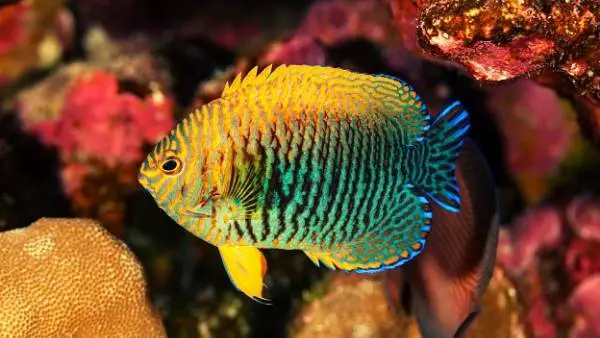
These angels do have a tendency to be slightly aggressive towards new fish arrivals once it has become established, they may also occasionally nip at large stony corals and some soft coral polyps. This is why it is important to have plenty of algae in your tank that they can feed on, rather than your coral.
2. Flame Angelfish
The famous Flame angelfish (Centropyge loricula) is a tropical fish originating from the Pacific Ocean. Their population is not under threat despite not being able to breed in captivity yet. Flame angels will typically grow to 4 inches (10 cm) in length and sport a bright orange body, almost resembling the color of fire, with a black spot and four bars on either side. They are so colorful, in fact, that they even made it onto our list consisting of the most colorful saltwater fish!
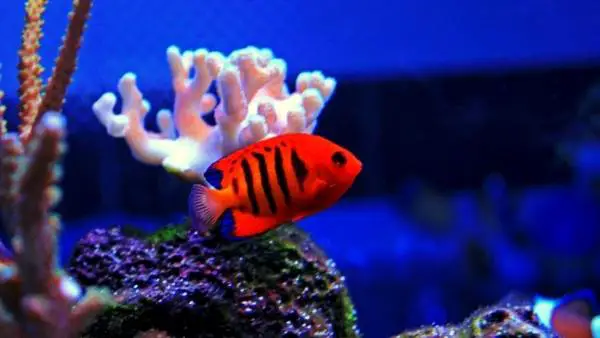
These angels are certainly considered reef safe and they adapt very well to new environments and diets. If you notice a flame angel picking at bits of rock and coral this is probably because you are not feeding them enough regularly. Mysis shrimp or frozen clams in addition to their regular food are perfect for a balanced diet.
3. Cherub Angelfish
Cherub Angelfish (Centropyge argi) is one of the rare angelfish that prefer reef tanks to regular fish tanks. Unfortunately, you may still see them eating the mucus that forms on the coral in your tank, which will then result in the coral retracting and dying. To avoid this problem make sure they are provided with enough food and algae to eat, they are fantastic saltwater algae eaters.
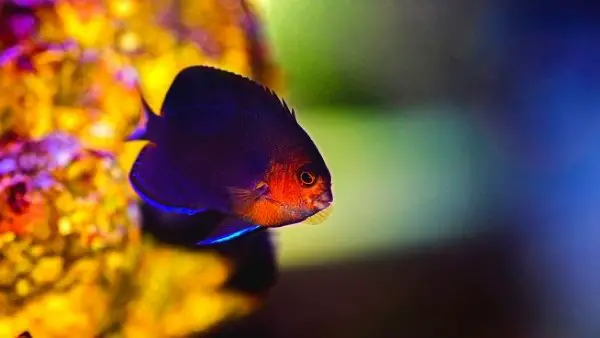
So, cherub angels are a brilliant option, however, introduce them into your tank with caution and keep an eye on them and how they behave around your coral reef. These fish will grow to 3 inches (8 cm) and have a beautiful metallic blue/purple body, with an incredibly unique bright yellow head.
4. Swallowtail Angelfish
The alluring Swallowtail angelfish (Genicanthus semifasciatus) is a planktivore and will typically spend its days swimming around in search of algae to feed off. They are truly beautiful fish that originate from Japan and are one of the few to feature on this list that is completely "reef safe" not harming any corals or invertebrates at all.
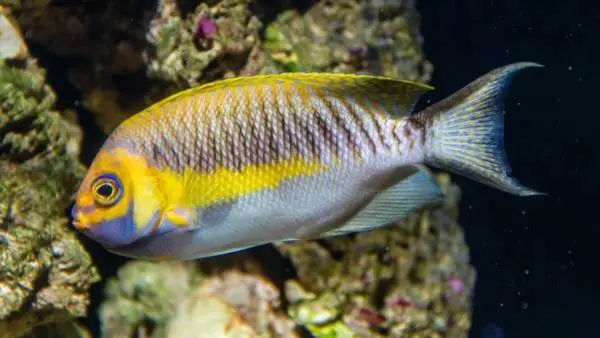
They are one of the biggest angelfish species, growing to around 6 inches (15 cm) in length and they display a yellow stripe on their back with a light blue body, their tails also contain black stripes.
5. Coral Beauty Angelfish
Coral beauty angelfish (Centropyge bispinosa) is one of the most popular dwarf angelfish or pygmy angelfish species out there and for good reason. Their hardiness, fantastic coloration, and low cost and maintenance all play huge factors in this fish's popularity.
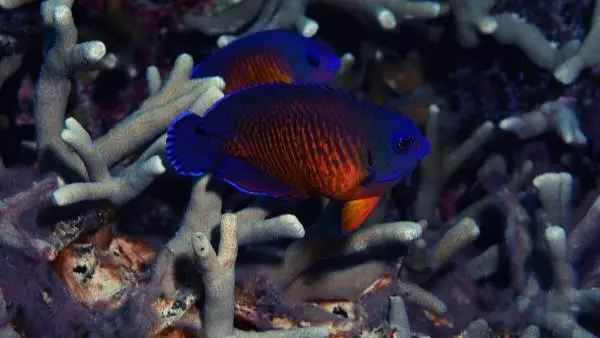
They will occasionally nip at large-polyp stony corals, but this is typically a rarity. If the fish has plenty of hiding spots, a big open area to swim around, and live rock then they will usually keep away from damaging corals. They grow to 4 (10 cm) inches in length and showcase a royal blue body, highlighted with orange/yellow stripe pattern.
6. Pearlback Angelfish
Pearlback angelfish (Centropyge multicolor) are extremely popular, however, they are semi-aggressive, especially if they are residing in a smaller tank where there is less room to establish a territory. They may occasionally nip at stony and soft corals, but they are considered reef safe.
To avoid damage to your tank and other fish that are in it, you should consider a large tank with plenty of live rock and hiding spots. They grow to 3.5 inches (9 inches) in length and have a beautiful peach-colored body with black speckles on their neon purple/blue heads.
Final Thoughts
Reef safe angelfish for saltwater aquariums are relatively hard to come by, but the fish that feature on this list are certainly the best options. It is important to bear in mind that, despite being on this list and considered reef safe, they can still do potential damage to your coral reef tank. Once introduced, make sure you monitor your fish's behavior to ensure they do not start damaging your reef tank!
